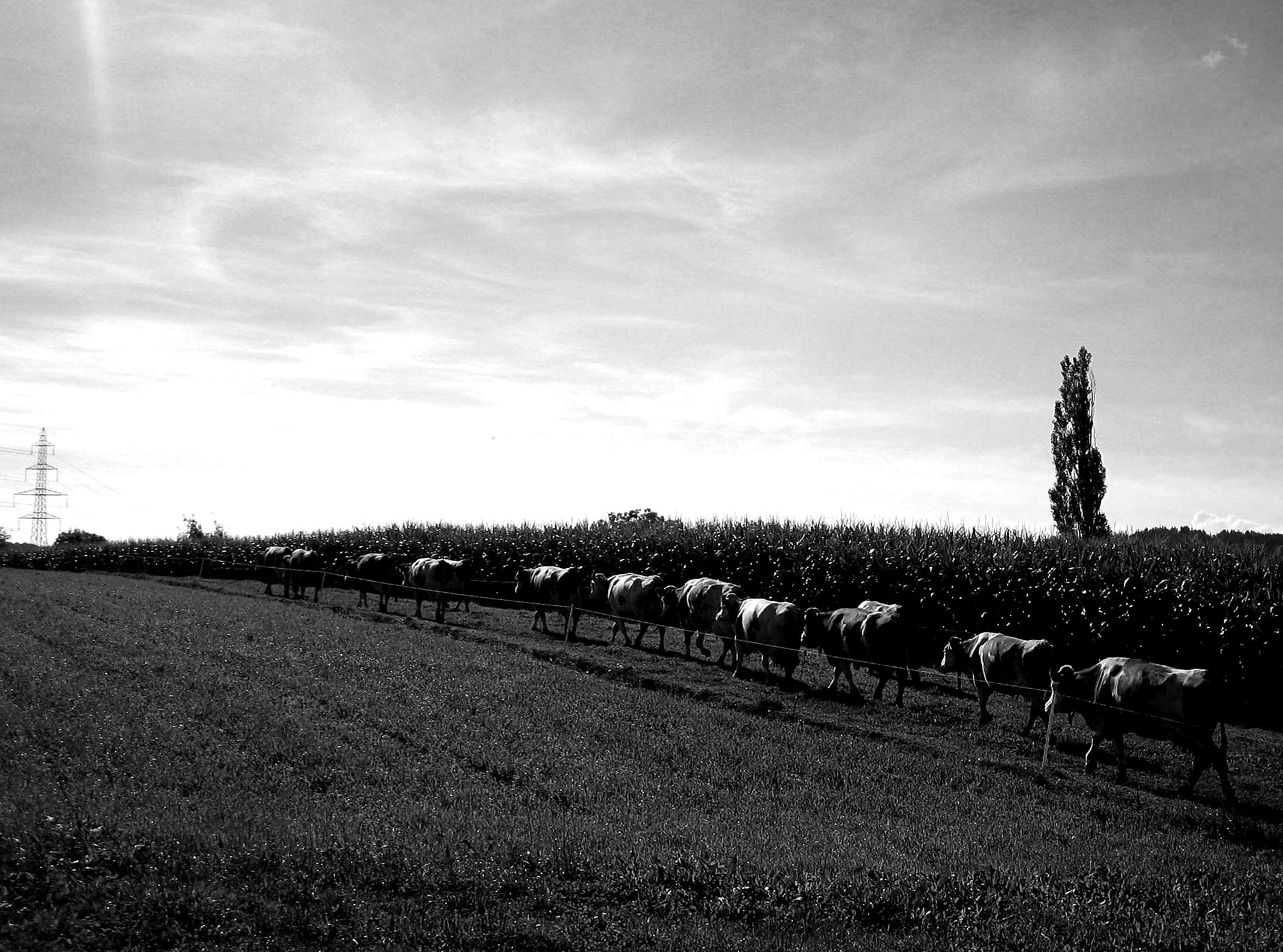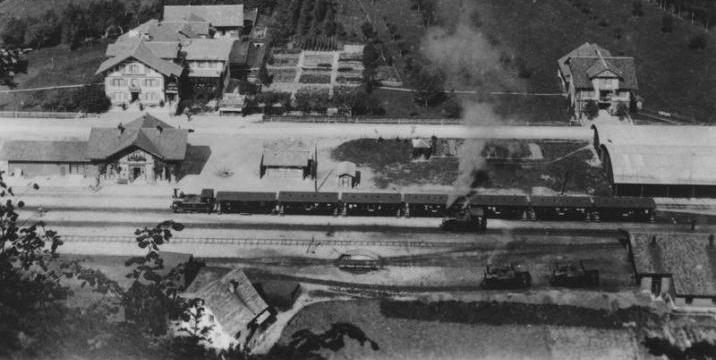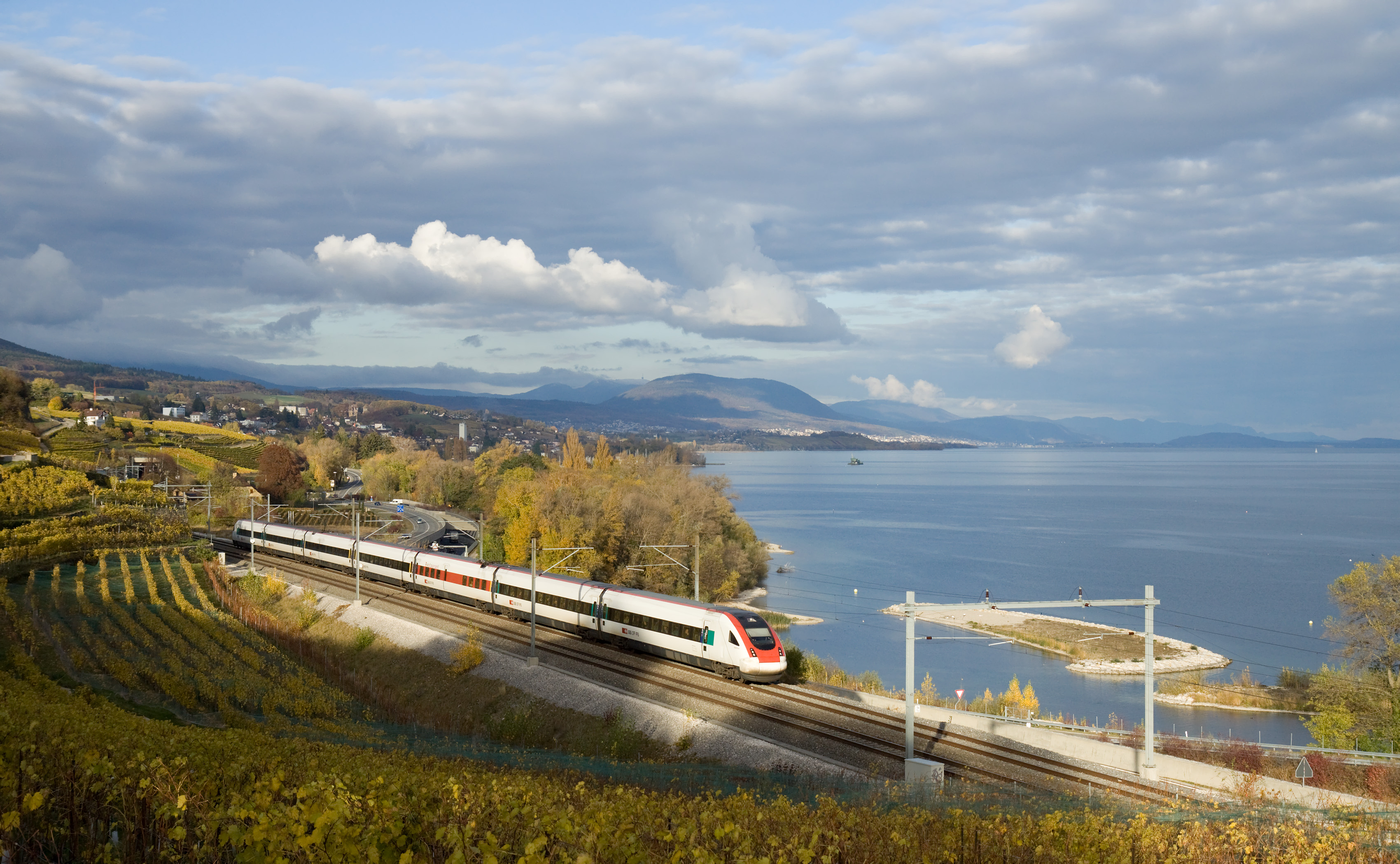|
Palézieux–Lyss Railway
The Palézieux–Lyss railway is a single-track standard-gauge line of the Swiss Federal Railways (SBB) in Romandy. The section south of Kerzers is sometimes considered to form one of two lines that intersect at Payerne station and are referred to in French as the ''Ligne de la Broye'' (Broye line) or in German as the ''Broyelinien'' (Broye lines) or ''Broyetallinien'' (Broye valley lines). The Palézieux–Lyss railway includes the ''Broye longitudinal'' ( Palézieux–Payerne– Murten–Kerzers). The Fribourg–Yverdon railway is considered to form the ''Broye transversal'' ( Yverdon-les-Bains–Payerne–). The lines are named after the Broye river, which passes through the cantons of Vaud and Fribourg, crossing the cantonal border ten times in total. History The line was opened in two stages: * 12 June 1876: Murten–Kerzers–Lyss, * 25 August 1876: Murten–Palézieux The line between Palézieux and Fräschels was owned by the Western Swiss Railways (''Chemins de ... [...More Info...] [...Related Items...] OR: [Wikipedia] [Google] [Baidu] |
Swiss Federal Railways
Swiss Federal Railways (german: link=no, Schweizerische Bundesbahnen, ''SBB''; french: link=no, Chemins de fer fédéraux suisses, ''CFF''; it, Ferrovie federali svizzere, ''FFS'') is the national railway company of Switzerland. It is usually referred to by the initials of its German, French, and Italian names, either as SBB CFF FFS, or used separately. The Romansh version of its name, ''Viafiers federalas svizras'', is not officially used. The official English abbreviation is "SBB", instead of the English acronym such as "SFR", which stands for ''Swiss Federal Railways'' itself. The company, founded in 1902, is headquartered in Bern. It used to be a government institution, but since 1999 it has been a special stock corporation whose shares are held by the Swiss Confederation and the Swiss cantons. It is currently the largest rail and transport company of Switzerland, and operates on most standard gauge lines of the Swiss network. It also heavily collaborates wi ... [...More Info...] [...Related Items...] OR: [Wikipedia] [Google] [Baidu] |
Palézieux
Palézieux () is a village and former municipality in the district of Lavaux-Oron in the canton of Vaud in Switzerland. Since 2012 it forms part of the municipality of Oron. History Palézieux is first mentioned in 1134 as ''de Palaisol''. Under the rule of Savoy, the family ''de Palézieux'' – mentioned in texts from 1154 – had their castle near the village, of which remains can be seen today (mainly a wall). The castle controlled a bridge on the River Broye, which was a source of profit through the various tolls and taxes. The bridge over the Broye was washed away in 1700, following a flood. It was rebuilt in 1750, following several petitions. Modernized, it is still in place. The creation of the separate settlement at Palézieux-Gare came about with the commissioning of the railway line between Lausanne and Bern in 1862, which was built away from the original village (which became known as Palézieux-Village). In 1876 the line from Payerne was added, which runs adjac ... [...More Info...] [...Related Items...] OR: [Wikipedia] [Google] [Baidu] |
Moudon
Moudon (; la, Minnodunum; german: Milden) is a municipality in the canton of Vaud in Switzerland. It was the seat of Moudon District and is now in the Broye-Vully district. History Montmagny was known as ''Minnodunum'' or ''Minnidunum'' during the Roman era. Around 1100, 1154 and 1180 it was mentioned as ''Meldun'', in 1161 it was ''Moudon'' and in 1167 as ''Meldunum'' or ''Mildunum''. As ancient Minnodunum, during Roman times, the city was in the country of the Helvetii, on a road from Viviscus (modern Vevey), on the Lake of Geneva, to Aventicum (modern Avenches). Geography Moudon has an area, , of . Of this area, or 46.7% is used for agricultural purposes, while or 35.1% is forested. Of the rest of the land, or 16.5% is settled (buildings or roads), or 1.8% is either rivers or lakes and or 0.1% is unproductive land. [...More Info...] [...Related Items...] OR: [Wikipedia] [Google] [Baidu] |
Lake Morat
Lake Morat or Lake Murten (french: Lac de Morat ; german: Murtensee) is a lake located in the cantons of Fribourg and Vaud in the west of Switzerland. It is named after the small bilingual town of Murten/Morat on its southern shore. It is the smallest of the three lakes in the Seeland or Pays des trois lacs area of the Swiss plateau located at the foot of the first chain of the Jura mountains. The main tributary is the river Broye. Since the Jura water correction its water leaves the lake through the Broye Canal (''Canal de la Broye'') into nearby Lake Neuchâtel that is connected to Lake Bienne/Lake Biel through the Thielle canal. Thus all three lakes form a natural reservoir in order to retain overflow water from the river Aare that flows into Lake Bienne/Biel: in times of combined heavy rainfalls and glacier melting in the Alps The Alps () ; german: Alpen ; it, Alpi ; rm, Alps ; sl, Alpe . are the highest and most extensive mountain range system that lies en ... [...More Info...] [...Related Items...] OR: [Wikipedia] [Google] [Baidu] |
Léman Express
The Léman Express is a commuter rail network for the transborder agglomeration of Grand Genève (''Greater Geneva'') in west Switzerland and the French Alps (Haute-Savoie and Ain). Six lines serve Swiss and French towns along 230 km of railway. At the heart of the Léman Express system is the CEVA rail project linking Eaux-Vives station with Cornavin station in Geneva. This line, largely underground, was opened on 15 December 2019. The Léman Express marked the start of direct services from Genève-Cornavin station to the French cities of Évian, Thonon, Annemasse and Annecy as well as the population of the Arve Valley up to Saint-Gervais-les-Bains. Lines The Léman Express operates daily from 5am to 12:30am and hourly overnight on Friday and Saturday nights between Coppet and Annemasse. Ridership Upon the full launch of the network in December 2019, it was hoped ridership would be around 50,000 travelers per day by the end of the next year; at the beginni ... [...More Info...] [...Related Items...] OR: [Wikipedia] [Google] [Baidu] |
Third Rail
A third rail, also known as a live rail, electric rail or conductor rail, is a method of providing electric power to a railway locomotive or train, through a semi-continuous rigid conductor placed alongside or between the rails of a railway track. It is used typically in a mass transit or rapid transit system, which has alignments in its own corridors, fully or almost fully segregated from the outside environment. Third rail systems are usually supplied from direct current electricity. Modern tram systems, street-running, avoid the risk of electrocution by the exposed electric rail by implementing a segmented ground-level power supply, where each segment is electrified only while covered by a vehicle which is using its power. The third-rail system of electrification is not related to the third rail used in dual gauge railways. Description Third-rail systems are a means of providing electric traction power to trains using an additional rail (called a "conductor rail") ... [...More Info...] [...Related Items...] OR: [Wikipedia] [Google] [Baidu] |
Chemins De Fer Du Jura Bernois
The Bernese Jura Railway (''Chemins de fer du Jura bernois'', abbreviated ''Jura bernois'', JB) was a railway company in Switzerland. The company was called the Jura–Bern–Luzern (''Jura–Bern–Lucerne'', JBL) from 1 July 1884. The Jura–Bern–Lucerne merged with the Western Switzerland–Simplon Railways (''Suisse-Occidentale–Simplon'', SOS) to form the Jura–Simplon Railway (''Jura-Simplon-Bahn''), JS) on 1 January 1890. History The railway network of the Canton of Bern initially developed according to the interests of the Swiss Central Railway (''Schweizerische Centralbahn'', SCB). The Grand Council of Bern, decided to conclude a contract with the SCB in 1852. The Central Railway undertook to build the Murgenthal–Bern line and the Solothurn–Herzogenbuchsee railway within four years and in return received tax exemption and the privilege of being given preferential treatment in future grants of concessions to build railways. The Central Railway’s constructi ... [...More Info...] [...Related Items...] OR: [Wikipedia] [Google] [Baidu] |
Jura Foot Railway
The Jura Foot Line (french: ligne du Pied-du-Jura, german: Jurafusslinie) or Jura South Foot Line, is a railway line in Switzerland. It runs from Olten along the foot of the southern Jura range through Solothurn, Grenchen, Biel/Bienne, Neuchâtel, Yverdon-les-Bains and Morges to Lausanne. It is one of two routes used by intercity trains between Geneva and Zürich. The other is the Midland line (German: ''Mittellandlinie'') which connects Olten via Langenthal, Burgdorf, Bern, Fribourg, Lausanne to Morges. The line was built by five railway companies, which after several mergers were absorbed into the Swiss Federal Railways in 1903. The line is electrified at 15 kV 16.7 Hz AC and is two track almost throughout. The sole remaining single section, south of Twann station and north of Neuveville, is the location of the new Ligerz Tunnel. This is due to open at the end of 2026 and will complete the double-tracking of the line. The southern part of the line forms part of the Laus ... [...More Info...] [...Related Items...] OR: [Wikipedia] [Google] [Baidu] |
Western Swiss Railways
The Western Switzerland Railways (''Chemins de fer de la Suisse Occidentale'', shortened to ''Suisse-Occidentale''; SO or S-O), were initially a joint operation of three Swiss railway companies, but these companies merged on 1 January 1872. The company was called the Western Switzerland–Simplon Railways (''Chemins de fer de la Suisse Occidentale et du Simplon'', shortened to ''Suisse-Occidentale–Simplon''; SOS or SO-S) from 28 June 1881. The SOS merged with the Bernese Jura Railways (''Chemins de fer du Jura bernois''; JBL) to form the Jura–Simplon Railways (''Compagnie des Chemins de Fer Jura–Simplon''; JS) on 1 January 1890. Association of the Railways of Western Switzerland In the early 1860s, the rail links between Romandy and German-speaking Switzerland were controlled by three railway companies, the West Switzerland Company (''Compagnie de l’Ouest Suisse''; SO), the Franco-Swiss Company (''Franco-Suisse'', FS) and the Lausanne–Fribourg–Bern Railway (''Chemi ... [...More Info...] [...Related Items...] OR: [Wikipedia] [Google] [Baidu] |
Fräschels
Fräschels (German) or Frasses (, ) is a municipality in the district of See in the canton of Fribourg in Switzerland. History Fräschels is first mentioned in 1225 as ''Frescin''. In 1228 it was mentioned as ''Frasses'' in French. Geography Fräschels has an area, , of . Of this area, or 71.3% is used for agricultural purposes, while or 17.2% is forested. Of the rest of the land, or 10.5% is settled (buildings or roads), or 0.6% is either rivers or lakes and or 0.3% is unproductive land.Swiss Federal Statistical Office-Land Use Statistics 2009 data accessed 25 March 2010 Of the built up area, housing and buildings made up 6.7% and transportation infrastructure made up 3.2%. Out of the forested land, 15.6% of the total land area is heavily for ... [...More Info...] [...Related Items...] OR: [Wikipedia] [Google] [Baidu] |
Canton Of Fribourg
The canton of Fribourg, also canton of Freiburg (french: Canton de Fribourg ; german: Kanton Freiburg ; frp, Canton de Fribôrg rm, Chantun Friburg it, Canton Friburgo) is located in western Switzerland. The canton is bilingual, with French spoken by more than two thirds of the citizens and German by a little more than a quarter. Both are official languages in the canton. The canton takes its name from its capital city of Fribourg. History On the shores of Lake Neuchâtel and Lake Morat significant traces of prehistoric settlements have been unearthed. The canton of Fribourg joined the Swiss Confederation in 1481. The area is made up of lands acquired by the capital Fribourg. The present extent was reached in 1803 when Murten (Morat) was acquired. The canton of Fribourg joined the separatist league of Catholic cantons in 1846 ( Sonderbund). The following year, its troops surrendered to the federal army. Geography The canton is bounded to the west by Lake Neuchâtel, to ... [...More Info...] [...Related Items...] OR: [Wikipedia] [Google] [Baidu] |
Canton Of Vaud
Vaud ( ; french: (Canton de) Vaud, ; german: (Kanton) Waadt, or ), more formally the canton of Vaud, is one of the 26 cantons forming the Swiss Confederation. It is composed of ten districts and its capital city is Lausanne. Its coat of arms bears the motto "Liberté et patrie" on a white-green bicolour. Vaud is the third largest canton of the country by population and fourth by size. It is located in Romandy, the French-speaking western part of the country; and borders the canton of Neuchâtel to the north, the cantons of Fribourg and Bern to the east, the canton of Valais to the south, the canton of Geneva to the south-west and France to the west. The geography of the canton includes all three natural regions of Switzerland: the Jura Mountains, the Swiss Plateau and the (Swiss) Alps. It also includes some of the largest lakes of the country: Lake Geneva and Lake Neuchâtel. It is a major tourist destination, renowned for its landscapes and gastronomy. The largest city is ... [...More Info...] [...Related Items...] OR: [Wikipedia] [Google] [Baidu] |




.jpg)




